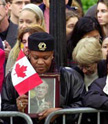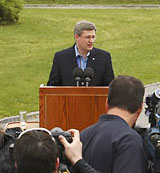Relic hunter part deux .. Ontario premier now dead against Senate reform .. mostly anyway?
Sep 23rd, 2006 | By Randall White | Category: Canadian Provinces When Ontario Premier Dalton McGuinty started making noises against Prime Minister Stephen Harper’s plans for Canadian Senate reform this past spring, it still seemed possible for the strange but hardy breed of local Ontario Senate reformers to believe that there was some deeper message between the lines. Now two excellent reports by Susan Delacourt in the Toronto Star this past week urge that the margin for all such beliefs has almost dwindled to zero. Yet a few puzzling loose ends remain. And Canada-first Senate reformers in Canada’s most populous province can probably still keep a little hope alive.
When Ontario Premier Dalton McGuinty started making noises against Prime Minister Stephen Harper’s plans for Canadian Senate reform this past spring, it still seemed possible for the strange but hardy breed of local Ontario Senate reformers to believe that there was some deeper message between the lines. Now two excellent reports by Susan Delacourt in the Toronto Star this past week urge that the margin for all such beliefs has almost dwindled to zero. Yet a few puzzling loose ends remain. And Canada-first Senate reformers in Canada’s most populous province can probably still keep a little hope alive.
EXECUTIVE/VOTER’S SUMMARY
At first it seems almost impossible to altogether make sense of the position on Canadian Senate reform that various Ontario provincial government spokespersons have advanced over the week of September 1822, 2006.
It is clear enough that Premier McGuinty’s Ontario government believes step two of Prime Minister Harper’s current two-step kickoff plan for more serious Senate reform down the road – the one that involves moving towards some transitional new semi-elected Senate – will require opening up the Constitution. And Ontario aggressively opposes doing this at the present time.
It is also clear enough that, if the federal government were to go ahead with step two and open up the Constitution in spite of Ontario’s good advice, Ontario’s preferred Senate reform strategy would simply be to abolish the Senate.
However, what still seems a bit puzzling is just what the final related proposition that various Ontario spokespersons have advanced is meant to mean. It appears to be saying that if the federal government were to further go ahead with its plans in a way that also ignored Ontario’s preference for abolishing the Senate, the Government of Ontario will vigorously oppose any proposal for a reformed Senate that does not pay all due attention to the plain demographic truth that the present Province of Ontario is home to almost four out of every 10 Canadians.
On the hypothesis that especially this last proposition has just not been very well researched (because after all Ontario just doesn’t see Senate reform as any kind of priority in the first place), it might seem to mean that the present Government of Ontario believes in something as absurd as having representation by population in both houses of the federal parliament.
Yet things look a bit different when you look more closely at the wider context of current provincial views on the Harper step-by-step Senate reform scheme, with special reference to voices from Alberta and BC (and Quebec too of course).
From this angle, it also seems conceivable that Premier McGuinty’s Ontario government is trying to say something considerably more sensible about the longer term design of the Senate reform towards which Mr. Harper’s step-by-step strategy seems to be headed – in as diplomatically obscure a manner as it can muster, in the midst of its other more urgent federal-provincial priorities on such things as equalization payments and “fiscal imbalance.”
In a much less diplomatic nutshell, what the Province of Ontario is really trying to say, on this hypothesis, is just that any rigorous version of what the Province of Alberta is still claiming as its cherished “Triple E” reformed Senate – with equal numbers of Senators for each province – is just altogether beyond anything that can possibly work in the real world of Canada today.
Put another way, the point is not just that almost four out of every 10 Canadians live in Ontario. It is also that the present six least populous Canadian provinces – which together would command a majority in any reformed Senate with equal representation for each province – together account for somewhat less than 14% of the total Canada-wide population.
And, even or especially in a reformed Senate that is supposed to be all about much more effective regional representation, as opposed to strict representation by population, just how much influence is somewhat less than 14% of the total Canada-wide population supposed to have?
This may be a question you might especially expect a province with some 39% of the population to raise. But it is far from a foolish question for all of the Canadian people.
(As Gordon Gibson from British Columbia has been trying to point out this past week as well … And for the latest update on this subject see the counterweights editors on WHY THE LIBERALS SHOULD BACK CANADIAN SENATE REFORM.)
1. Mr. Harper’s first two steps …
 If you really are up for yet another strange adventure on a strange long journey in Canadian politics, it is worth bearing in mind that Prime Minister Harper’s current “step-by-step” plans for reform at last of the nationally embarrassing old political insiders’ joke that is called the Senate of Canada (or “relic of the 19th century,” as Mr. Harper himself more diplomatically says) are themselves quite modest.
If you really are up for yet another strange adventure on a strange long journey in Canadian politics, it is worth bearing in mind that Prime Minister Harper’s current “step-by-step” plans for reform at last of the nationally embarrassing old political insiders’ joke that is called the Senate of Canada (or “relic of the 19th century,” as Mr. Harper himself more diplomatically says) are themselves quite modest.
As Susan Delacourt nicely explains in her latest Toronto Star reports, at present Mr. Harper is only trying to take the first two steps on a much longer journey:
“The government has introduced a bill to limit Senate terms to eight years, and it’s being called the first step on the path to an elected Senate. The second step is the legislation now being drawn up … to allow Canadians to elect would-be senators, perhaps as soon as the next time the country goes to the polls … which Harper believes will need only the approval of Parliament.”
According to Ms. Delacourt’s “Queen’s Park source … Ontario doesn’t intend to object to the government’s plan to limit Senate terms … but anything else that is in the proposal of the Prime Minister at this point means that the Constitution has to be opened up and we are aggressively opposed to that,’ the source said.” Queen’s Park, that is to say, will be giving Mr. Harper a bye on the first step of his current plans, but not on step two.
2. The constitutional issue on the second step – how many angels can fit on the head of a pin?
 Mr. Harper himself believes that he can proceed with step two without opening up the Constitution – and thus without soliciting its required degree of provincial approval. His case is that his interim proposal to hold “elections” just for all future Senate appointments he may make as prime minister – as is his prerogative under the Constitution as it stands – “will need only the approval of Parliament” in Ottawa.
Mr. Harper himself believes that he can proceed with step two without opening up the Constitution – and thus without soliciting its required degree of provincial approval. His case is that his interim proposal to hold “elections” just for all future Senate appointments he may make as prime minister – as is his prerogative under the Constitution as it stands – “will need only the approval of Parliament” in Ottawa.
Or, it is true enough that: “Under the Constitution, any substantial changes to the powers or representation of the Senate, as well as the selection of senators, need to be approved by at least seven provinces, representing at least half the Canadian population.”
But Mr. Harper “appears to envision a gradual democratization system for the unelected Senate, in which citizens would vote for senators he would then appoint to the chamber.” And “since senators would still be technically appointed – after they’re elected in a national consultation’ – Ottawa could argue it hadn’t changed the Senate substantially.”
Alas, “Ontario’s Attorney General, Michael Bryant, has reportedly decided that this is an attempt to bring substantial change through the back door.” So, according to Ms. Delacourt’s Queen’s Park source, even Mr. Harper’s clever second step towards a kind of semi-elected Senate “according to our attorney general, who’s also a constitutional expert, will require that the Constitution will have to be opened.”
Of course, those of us who are not constitutional experts can only scratch our heads at all this. At the bottom of everything, deciding whether Mr. Harper can make any future prime ministerial Senate appointments by soliciting advice from the people of Canada via consultative elections, without first securing a constitutional amendment, is like deciding how many angels can fit on the head of a pin.
And the only possible ultimate decisive answer is whatever a majority of the Supreme Court of Canada might finally decide.
3. Who’s afraid of the interim Frankenstein Senate?
 The crux of the matter is whether you think that at least starting to get the ball rolling on the reform of the longstanding political joke of the Senate of Canada is very important, at this juncture in the endless gradualism of Canadian political development.
The crux of the matter is whether you think that at least starting to get the ball rolling on the reform of the longstanding political joke of the Senate of Canada is very important, at this juncture in the endless gradualism of Canadian political development.
The immediately obvious objection to Mr. Harper’s interim Senate semi-election scheme (i.e. “step two”), e.g., is that it would de-stabilize the current Senate – and even possibly the federal Parliament in Ottawa at large. At worst (or best, depending on your point of view) it might create some kind of interim Frankenstein Senate, that nobody could live with too much longer.
Some, even for some time many, and of course all of the current Senators would still have been appointed on the old method. But some and over the next decade say even increasing numbers of new Senators would be appointed for an eight-year term on the new election method. (Assuming either that all of Mr. Harper’s successors as prime minister would feel obliged to carry on with his good work, or that he himself will be remaining in office for quite some time yet.)
The new elected appointees would have more popular credibility and political weight and heft than the old ones. The Frankenstein Senate might even try to throw a little weight around relative to the Canadian House of Commons, as it has not done for about 100 years now at least.
4. Whatever … just not a priority for Ontario … and just abolishing the Senate best in any case
From the standpoint of most of the Canadian people, who do not live in the national or federal capital area, it is not all that easy to see how any such potential interim Frankenstein Senate developments would really do much more than add a little extra colour and minor drama to Ottawa life.
And, most importantly (if you really do believe in Senate reform now), whatever happens would be bound to put continuing pressure on all future federal and provincial governments to proceed with steps three, four, and so forth – and finally bring the Canadian national embarrassment of the 19th century relic to some kind of altogether sensible, democratically elected, and suitably regionally representative 21st century end.
Yet, whatever else, it is now utterly clear that Ontario Premier Dalton McGuinty is definitely not someone who, as they say, buys into this urgent at-least-let’s-get-started-with-Senate-reform scenario. As the premier himself told the press on Wednesday, September 20: “Senate reform is not a priority for Ontarians.”
Moreover, if Prime Minister Harper presses ahead with his plans, and actually does try to open up the constitutional question (as Ontario believes will be required even by step two), then the current Government of Ontario’s main thought about how to deal with the historic national embarrassment of the Senate of Canada is still to just get rid of the whole thing altogether.
5. Senator Comeau’s Nova Scotia plea for a more nation-building Ontario
 Many will say all this is hardly surprising. One key objective of the modern Western Canadian inspired movement for Senate reform is to cut the glorious but overweight Canadian Province of Ontario down to size on the federal scene. Why in the world would Ontario be in favour of that?
Many will say all this is hardly surprising. One key objective of the modern Western Canadian inspired movement for Senate reform is to cut the glorious but overweight Canadian Province of Ontario down to size on the federal scene. Why in the world would Ontario be in favour of that?
On the other hand, as Ms. Delacourt also nicely reports, there is another view of Ontario’s role in confederation. And Senator Gerald Comeau, a Conservative from Nova Scotia, raised this point with Ontario intergovernmental affairs minister, Marie Bountrogianni, when she appeared before the unreformed Senate’s committee looking into Senate reform, on Thursday, September 21.
In Senator Comeau’s words: “Historically, the role of Ontario has been the great unifier of provinces in the nation. And [now] you’re saying We’re not interested, don’t even go there, we don’t want to have anything to do with making the nation better’ … How do I go back to Nova Scotia and say that the Ontario that used to be able to defend us, to unify the nation, is saying go fly a kite … we are minding our own backyard?'”
Minister Bountrogianni’s ultimate response to this question, as Ms. Delacourt notes, echoed Ontario’s current “rhetoric surrounding the fiscal imbalance talks” between Ottawa and the provinces, in which Dalton McGunity’s government is at the moment much more interested than it is in Senate reform. Minister Bountrogianni finally “said she realized some senators had been struck by Ontario’s more aggressive, us-first attitude. I think Ontario’s proud to help the rest of the provinces that need help, but I also think that we have to advocate for Ontarians,’ she said.”
6. Nation building and province building in the most populous province
If she had been given more time, Minister Bountrogianni might have gotten into a more extended history lesson with Senator Comeau.
In fact, in any case, if you look at things in the broad sweep of history since the start of the present confederation in 1867, there is indeed Ontario the nation builder – as when William Davis at Queen’s Park stood beside Pierre Trudeau in Ottawa, in the events that finally gave Canada its new Constitution Act 1982.
But there is also Ontario the province builder, that just worries about minding its own backyard.
See, e.g., the long career of the original grand old dead white male of Ontario provincial politics, Oliver Mowat, Liberal premier without interruption from 1872 to 1896. Mowat was one of the inventors of the province-building strategy in Canadian political development, and the original anglophone provincial arch-rival and antagonist of John A. Macdonald in Ottawa.
Mowat’s example would live on long after his demise, in various subtle and not-so-subtle ways. He would find a particularly enthusiastic successor in “Canada’s Huey Long,” Mitch Hepburn, Liberal premier of Ontario from 1934 to 1942. (And see the new All the King’s Men movie that premiered at the recent Toronto International Film Festival for more on Huey Long, as interpreted by the unrepentant cigarette-smoker Sean Penn.)
After a long alternative bout of Ontario the nation builder, following the Second World War (which is no doubt what Senator Comeau has mostly in mind), as Minister Bountrogianni has also been explaining to various interested parties lately, Ontario has been gradually moving back to its historic province-building posture ever since the Liberal regime of David Peterson (19851990), for what successive premiers have seen as its own very good present-day reasons.
7. Just how bad has the Ontario research been anyway?
If she had been able to spend a great deal of time with the Senate committee on Senate reform on September 21 Minister Bountrogianni might conceivably have told Senator Comeau as well that, although the current Ontario position certainly is quite strongly tilted in the province-building direction, it has not altogether overlooked Ontario’s historic nation-building responsibilities.
That at any rate would seem to be the most rational explanation for what has otherwise struck some observers as the most puzzling loose end in what the Government of Ontario has been saying about Senate reform in the most recent past. The ultimate message, it seems, is just that, as Ms. Delacourt finally puts it: “Unless Ontario gains power in any proposed reforms of Parliament or the Senate, it’s not interested in change.”
Or, in somewhat greater detail, it almost seems that “Ontario no longer even accepts that Canada needs a federal institution to reflect regional or provincial equality – the historic purpose of the Senate … Bountrogianni made it clear that Ontario wants the House of Commons and the Senate to reflect the fact that Ontario has 39 per cent of Canada’s citizens. Or it wants no Senate at all … In other words, Ontario wants Canada to be one of the few countries – if not the only country – in the world to have two federal legislative bodies with representation by population.”
It is also at this point that Susan Delacourt’s point about how it is “not clear … whether Ontario’s current positions” on Senate reform “have been well researched” may come most crucially into play. Those with more objective faith in the inherent rationality and assiduous homework of the present Ontario provincial political system will want to protest that surely things are not quite that bad?
8. Meanwhile back at the ranch in Alberta
 Surely, that is, the premier and his ministers’ recurrent reminders of “the fact that Ontario has 39 per cent of Canada’s citizens” in all this current federal-provincial sparring do not really mean that “Ontario wants Canada to be one of the few countries – if not the only country – in the world to have two federal legislative bodies with representation by population.” That would just be too absurd, even in Ontario.
Surely, that is, the premier and his ministers’ recurrent reminders of “the fact that Ontario has 39 per cent of Canada’s citizens” in all this current federal-provincial sparring do not really mean that “Ontario wants Canada to be one of the few countries – if not the only country – in the world to have two federal legislative bodies with representation by population.” That would just be too absurd, even in Ontario.
On this kind of rational expectations’ hypothesis, at least, to appreciate what Ontario’s recurrent reminders of its comparatively enormous share of the cross-Canada population really mean, you have to go back to some remarks from the Alberta intergovernmental affairs minister, Gary Mar, to the same Senate committee on reforming the Senate, on Tuesday, September 19.
Ms. Delacourt has reported helpfully on this branch of the subject as well. Minister Mar “told the Senate committee … that his province was generally in favour of Harper’s stage-by-stage approach.” (Except that it ideally wants the provinces to hold any new Senate elections involved – and “appears to be balking at the idea of Ottawa running any Senate elections, as Harper envisions.”)
Most importantly, so far as the longer-term future of step three and beyond goes, Alberta still “favours the Triple E’ Senate – elected, effective and with equal numbers of senators from each province. Mar said the Commons is designed to reflect equality of citizens, while the Senate should reflect equality of provinces in the federation.”
Then, as Ms. Delacourt goes on: “Ontario, however, is balking at the notion of equality” of provinces.” And, just on the face of things, this is of course not surprising for a province that, all by itself, is home to almost four out of every 10 Canadians.
Equality of the provinces, e.g., means that in the reformed Senate of Canada every one resident of Prince Edward Island will, so to speak, have as much influence as more than 91 residents of Ontario. And on just what theory of democratic regional representation, an Ontarian might reasonably ask, does it say that one Prince Edward Islander is worth more than 91 Ontarians?
9. And it’s not just Toronto … it’s Vancouver too?
 To appreciate the full nation-building rationality of just what Ontario finally seems to be saying (or may be saying) here, in the midst of all the creative federal-provincial confusion nowadays, it appears that you finally have to go to British Columbia on Canada’s Pacific Coast.
To appreciate the full nation-building rationality of just what Ontario finally seems to be saying (or may be saying) here, in the midst of all the creative federal-provincial confusion nowadays, it appears that you finally have to go to British Columbia on Canada’s Pacific Coast.
Or at least you have to pay attention to some further testimony this past week before the unreformed Senate committee on Senate reform in Ottawa – from the veteran Vancouver man about town and jack of all public policy trades (including time served with Pierre Trudeau), Gordon Gibson. As the Vancouver Sun has explained: “Prime Minister Stephen Harper’s Senate reform proposals could lead to a dangerous’ increase in conflict between rich and poor provinces that could eventually result in Canada’s breakup, former B.C. Liberal leader Gordon Gibson warned Wednesday [September 20].”
A dangerous conflict between rich and poor provinces? What does that mean? Just what is going on here anyway? Well, you could say, on Canada’s Pacific Coast Canadians often speak more plainly than they do in stodgy old Ontario. (And so another relic of the 19th century called C.C. James once alluded to “this prosy old province of Ontario” – and the Liberal “Christian Statesman” Oliver Mowat was frequently condemned by his opponents as an appalling hypocrite.)
At the bottom of everything it is not just that Ontario has almost 39% of the total Canada-wide population. Or that Quebec has more than 23%, British Columbia more than 13%, and Alberta more than 10% (and both BC and especially Alberta are currently growing like houses on fire). It is that the other six least populous provinces of the present confederation – which would together have a majority in any Triple E Senate with equal provincial representation – nowadays account for somewhat less than 14% of the total Canada-wide population.
When you add to this part of the equation the blunt fact that most of the six least populous provinces also typically receive rather than contribute to federal-provincial equalization payments (logically enough on one plane of rationality), you can start to better appreciate just what Gordon Gibson has in mind. (Or Dalton McGuinty for that matter, who is especially concerned about such things as equalization payments at the moment.) Yes, that is, the Senate is supposed to be all about regional (or geographic) representation as opposed to representation by population. But does that really have to mean that a properly reformed Senate of Canada will be dominated by the less than 14% of the cross-Canada population that lives in the least affluent but most numerous equal provinces?
And then, as the final icing on a somewhat different but related cake, to the east of the current most populous equal province of Ontario stands the current second most populous and unique Canadien francophone-majority province of Quebec – which Susan Delacourt also nicely alludes to in her latest reports in the Toronto Star. Quebec has always been resolute about the fact that while it may be an equal Canadian province, it is “not a province like the others.” And it has already held two referendums on exactly what this might eventually mean, in ways that could also “eventually result in Canada’s breakup.” Just what might Quebec do if the rest of the country told it that it was going to have the same representation in a reformed Triple E Senate as Prince Edward Island, etc?
10. And what about steps three and four etc … and should Prime Minister Harper even care about all that now?
 However you try to put them down on paper, these two mountainous obstacles – the unusual Canadian polarization between provinces with large and small populations, and the unusual position of Quebec in the Canadian confederation – finally sound a decisive death toll for any kind of reformed Triple E or other Senate of Canada, based on any strict principle of equal provincial representation.
However you try to put them down on paper, these two mountainous obstacles – the unusual Canadian polarization between provinces with large and small populations, and the unusual position of Quebec in the Canadian confederation – finally sound a decisive death toll for any kind of reformed Triple E or other Senate of Canada, based on any strict principle of equal provincial representation.
And that at least does seem to be the ultimate rational explanation for the emphasis that the current Government of Ontario puts on Ontario’s own comparatively vast share of the Canada-wide population, in its current and still somewhat murky position on Prime Minister Harper’s “step-by-step” Senate reform strategy.
At the same time, there still does seem to be a little room for Canada-first Senate reformers in Canada’s most populous province to keep hope alive. There are , e.g., at least three further points worth bearing in mind, in trying to interpret just what the current McGuinty government’s Senate reform position may or may not mean for the longer-term Canadian future:
(1) BETTER REGIONAL REPRESENTATION IN A REFORMED SENATE DOES NOT HAVE TO MEAN EQUAL PROVINCIAL REPRESENTATION. Along with its now quaintly absurd echoes of the old British House of Lords, the 19th century relic of the current unreformed and un-elected Senate of Canada already embodies a concept of regional representation that at least transcends any too simple-minded concept of equal provincial representation.
 This concept was something of a Red-Green-Duct-Tape fabrication at the start of the present confederation in 1867, and more duct tape has subsequently been added, in a way that no longer makes any kind of sense at all. As matters stand Ontario and Quebec each have 24 Senators, the original three Maritime Provinces of Atlantic Canada have 24 Senators (10 each for Nova Scotia and New Brunswick, and 4 for PEI), Western Canada has 24 Senators (6 each for BC, Alberta, Saskatchewan, and Manitoba), Newfoundland (which did not join confederation until 1949) has 6 Senators, and the present three northern territories have 1 Senator each.
This concept was something of a Red-Green-Duct-Tape fabrication at the start of the present confederation in 1867, and more duct tape has subsequently been added, in a way that no longer makes any kind of sense at all. As matters stand Ontario and Quebec each have 24 Senators, the original three Maritime Provinces of Atlantic Canada have 24 Senators (10 each for Nova Scotia and New Brunswick, and 4 for PEI), Western Canada has 24 Senators (6 each for BC, Alberta, Saskatchewan, and Manitoba), Newfoundland (which did not join confederation until 1949) has 6 Senators, and the present three northern territories have 1 Senator each.
Just as an abstract parlour game, it is not at all difficult to envision an improved system of regional representation that pays some homage to the concept of equal provincial representation, without pursuing it to its impossible extreme in 21st century Canadian circumstances.
Suppose, e.g., you adopt three simple principles: all provinces start with equal representation; but then any province with 10% or more of the Canada-wide population gets twice as many Senators; and then Quebec finally gets twice as many Senators again as the large population group, in deference to the fact that while it is indeed a sovereign Canadian province, just like all the others, it is also “not a province like the others.” This could give you a reformed regionally representative Senate with, say, 12 seats for Quebec, 6 seats each for BC, Alberta, and Ontario, and 3 seats each for Saskatchewan, Manitoba, Nova Scotia, New Brunswick, Newfoundland, and PEI, etc.
Premier McGuinty in his current frame of mind might further want to insist, say, that Ontario get 8 seats, on the grounds that any province with 25% or more of the Canada-wide population should get two extra seats, or something like that. And then all the other provinces would have to ask themselves what is wrong with that, and so forth.
Finally, however politically absurd all such parlour or armchair-quarterback calculations may seem to be right now, it does appear – from what Ottawa intelligence can be gleaned in the ordinary mass media – that Prime Minister Harper himself, and the federal government enthusiasts for Senate reform who currently surround him, have at least already accepted the ultimate impossibility of strict provincial representation as in the now historic Alberta Triple-E model.
(2) THE FIRST TWO STEPS OF MR. HARPER’S STRATEGY STILL LEAVE THE QUESTION OF REGIONAL REPRESENTATION FOR DOWN THE ROAD ANYWAY. At the very end of the day it is worth remembering that all Mr. Harper’s strategy currently envisions is taking the first two steps in a much longer and more gradual process of step-by-step reform. And both these steps simply accept the current system of regional representation (24 seats for Ontario and Quebec etc), and leave the question of improving it to the future.
 Thus a nation-building Ontario Senate reformer who supported something like the kind of reformed regional representation proposed as a parlour game above, e.g., could and can quite rationally and wholeheartedly support Prime Minister Harper’s current first two steps. The key argument here is that, as the eminent Atlantic Canadian political scientist Donald Savoie has also just urged, some kind of properly reformed federal Senate is important for the Canadian future. And, given everything else going on in the global village nowadays, the time to get started is now, etc.
Thus a nation-building Ontario Senate reformer who supported something like the kind of reformed regional representation proposed as a parlour game above, e.g., could and can quite rationally and wholeheartedly support Prime Minister Harper’s current first two steps. The key argument here is that, as the eminent Atlantic Canadian political scientist Donald Savoie has also just urged, some kind of properly reformed federal Senate is important for the Canadian future. And, given everything else going on in the global village nowadays, the time to get started is now, etc.
Moreover, Ms. Delacourt suggests at the end of her second excellent Toronto Star report that “the general resistance of Canada’s two largest provinces to Ottawa-imposed Senate elections [i.e. Mr. Harper’s step two] signals a rocky ride for Harper’s plans. It may signal, in fact, that the notion of Senate elections is doomed for now.”
Yet truly concerned nation-building Ontario Senate reformers may still want to ask themselves: What if Prime Minister Harper just goes ahead with his Ottawa-imposed Senate elections anyway – and tells provinces like Ontario, who believe that this requires a constitutional amendment with the approval of seven provinces and so forth, to just take their cases to court? Does Mr. Harper really have Ottawa cahones of this order, in the manner of Pierre Trudeau (and with the support of Alberta, say, the way Ontario supported Trudeau on what became the Constitution Act 1982)? Who knows? Maybe he does? Moreover, just what would the Supreme Court pronounce in the very end? It is said, e.g., that some eminent constitutional lawyers from both Ontario and Quebec do agree with Mr. Harper on the point.
(3) WOULD ONTARIO STILL THINK THAT STEP TWO REQUIRES A CONSTITUTIONAL AMENDMENT IF OTTAWA GAVE IT A SWEET DEAL ON THE FISCAL IMBALANCE? Finally, in trying to figure out what any provincial government is finally going to do on any matter, it often enough makes sense to pay the most attention to just what the provincial premier is saying.
 A Canadian Press report on Premier McGuinty’s Senate reform musings from this past week seems at least somewhat provocative in this context: “Should the prime minister be bound and determined to drive ahead with Senate reform, one of the things we’re going to be looking for is fair representation,’ McGuinty said … McGuinty wouldn’t discuss how the province plans to leverage more Senate seats, but said he would wait and see exactly what the prime minister wants to do.’ There are more pressing concerns facing Ontario residents, he added. Senate reform is not a priority for Ontarians.'”
A Canadian Press report on Premier McGuinty’s Senate reform musings from this past week seems at least somewhat provocative in this context: “Should the prime minister be bound and determined to drive ahead with Senate reform, one of the things we’re going to be looking for is fair representation,’ McGuinty said … McGuinty wouldn’t discuss how the province plans to leverage more Senate seats, but said he would wait and see exactly what the prime minister wants to do.’ There are more pressing concerns facing Ontario residents, he added. Senate reform is not a priority for Ontarians.'”
Mmm … Suppose that the Conservative prime minister wanted to do something nicer for the Liberal premier of the most populous province than he seems to have wanted so far, on some of those “more pressing concerns facing Ontario residents” – concerning the so-called federal-provincial fiscal imbalance, e.g., and the need among hard-pressed Ontario provincial taxpayers for more of the federal tax dollars they currently send to Ottawa, right back at good old Queen’s Park?
Is it conceivable that then the Attorney General of Ontario might look again at the constitutionality of Ottawa-imposed Senate elections in step two of Mr. Harper’s step-by-step Senate reform strategy, and decide that they don’t really require a constitutional amendment with the approval of seven provinces and so forth after all? Just how many angels can you finally fit on the head of a pin?
Randall White is the author of a number of books on Ontario and Canadian history and politics, including Ontario 1610-1985; Voice of Region: The Long Journey to Senate Reform in Canada; Ontario Since 1985; and, with the Toronto artist Michael J. Seward, On the Road in the GTA: An eclectic guide to the exurban sprawl of Greater Toronto. Since Voice of Region was first published in 1990, he has continued to follow the Senate reform issue in Canada.

